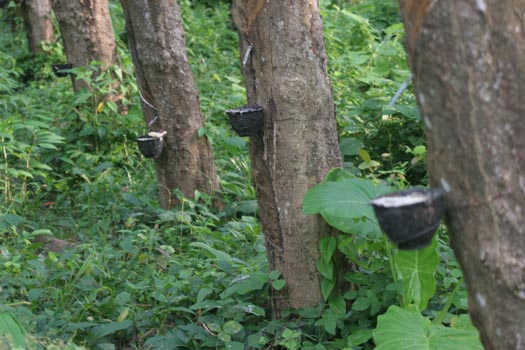A Brief History of Natural Latex

Christopher Columbus can be credited with the discovery of Natural Latex, or Rubber. When he returned to the New World for a second time, he noted natives of Haiti playing with a ball made from the gum of a tree. This bouncing ball made from the gum of a tree called "CAW-UCHU" or, "Weeping Wood", was also used by ancient Mayans. They threw it through a "hoop" made of rubber. It was the earliest form of a game which later became known as basketball.
The natives that played with "Bouncing Balls", also used "CAW-UCHU" to waterproof clothing and "rubberize" footwear.
In 1770, Joseph Priestly, an English chemist, "erased" pencil marks with coagulated rubber. Since it "rubbed off" pencil marks. He gave it the name "Rubber."
In the late nineteenth century, a Scotsman patented a garment which contained rubber and fabric. The raincoat was born.
During the same period a British coachman cut rubber into "strips" and created the rubber band.
The most significant discovery during that period was that of Charles Goodyear. He introduced Sulphur "Dust" into rubber and discovered Vulcanization. Vulcanized Rubber gives natural latex resistance to temperature extremes. This gave birth to our vast tire industry. In fact, in 1846, the tires of Queen Victoria's coach were made from Rubber.
Although rubber is available from a number of trees (e.g. the CASTILLOA ELASTICA in Mexico, and a climbing bush in Africa called LANDOPHILLIA), none is as productive as the HEVEA BRASILIENSIS, from Brazil, as far as ease of tapping and intensity of yield.
Seedlings of this tree were taken from the Amazon and transplanted to England. From there, they made their way to Ceylon and Singapore, where large farms were instituted. Some of the original transplants are still producing today.
It is also significant to note that during this period the process to "tapping" latex was developed. It was found that "tapping" the Hevea Brasiliensis improved the yield of the trees.
Most rubber trees grow to a height of 50 feet. They require climates that have annual rainfall of about 90 inches and temperatures of about 80 degrees Fahrenheit.
Today researchers at the Malaysian Rubber Institute are trying to develop trees with "fatter" stumps to produce more latex.
The production of more latex by creating more productive trees is becoming necessary as the needs of the medical profession expand.
Tremendous efforts are continuing to counteract the ephemeral nature of Latex by growing seedlings in nurseries and then later transplanting them in the field.
Unendangered, Hevea Brasiliensis will continue to produce the latex we need through these scientific tree farming techniques.
